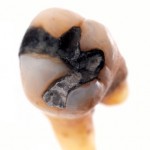How we protect you from mercury vapor exposure. When a dentist removes (drills) on an old amalgam filling, it releases a lot of mercury vapor. You can recognize an amalgam filling because it looks dark gray or silvery. When this mercury vapor is released, you can potentially breathe it in and then have it absorbed into your nervous system or other tissues.
Here’s what we do.
- Non-Latex Dental Dam
- Medical Air Nasal Hood
- High Volume Vacuum
- High Speed Suction
- Chunck Amalgam Removal
- Lots Of Water
- Protective Eyewear
- Ventilation
- Primary Health Provider Communication
Here’s what we do to protect you from mercury vapor during amalgam filling removal.
First, we use a non-latex dental dam. This is sometimes called a rubber dam; it prevents you from not only breathing in vapor through your mouth but also prevents that vapor from contacting the more permeable mucosa inside your mouth. We use a non-latex dam instead of latex because it resists mercury vapor better than latex does, and because many people have latex sensitivites.
The second thing we do to protect you from mercury vapor is we use a nasal hood supplied with medical air at a high flow rate. We use the same kind of clean, filtered air they use in an operating room. With this air rushing past your nose, you’re much less likely to breathe in mercury vapor from outside the nasal hood.
Third, we place a large, high-volume vacuum right under your chin. This draws a high percentage of escaping vapor away from you and into the vacuum. The vacuum itself has special filters in it that filter not only the particulates but also bind the mercury to special carbon and sulfur layers.
Fourth, we use a high speed suction next to the dental drill, and that suction stays next to the tooth throughout the procedure.
Fifth, we use suction underneath the dam in case any vapor makes it past the nitrile dam.
Sixth, we remove the amalgam in as big of pieces as possible by using thin burrs and sectioning the filling. This way, less mercury vapor gets released.
Seventh, we use lots of water to keep the amalgam cool.
Eighth, we give you protective eyewear.
Ninth, we ventilate the room throughout and after the procedure.
Last, we communicate with your whole-body practitioner to coordinate your dental treatment with your overall plan for detoxification and to optimize your whole-body health plan.





